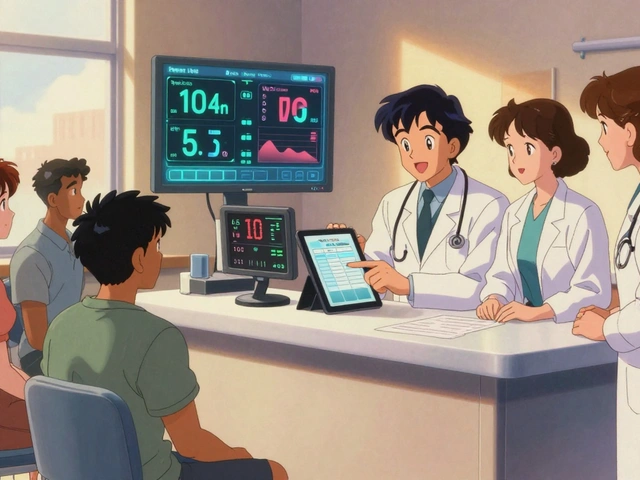Hypertension Support Group Finder
1. How comfortable are you meeting strangers face‑to‑face?
2. Do you have reliable internet access for video calls?
3. Would you like a mix of online and occasional in‑person meetings?
4. How much time can you dedicate weekly to group activities?
5. Do you prefer anonymity when sharing personal health details?
Support group is a structured gathering of individuals who share a common health challenge, in this case people living with hypertension. These meetings can be in‑person, virtual, or hybrid, and they focus on sharing experiences, coping strategies, and emotional encouragement. Hypertension is a chronic condition marked by consistently elevated blood pressure-usually above 130/80mmHg-putting strain on the heart and blood vessels. Medication alone rarely tackles the lifestyle and psychological barriers that keep numbers high, and that’s where hypertension support groups shine.
Emotional Backing and Peer Support
When you hear someone say, “I’m not alone,” the relief is immediate. Peer support provides a sense of belonging that combats isolation, a known driver of stress‑related blood‑pressure spikes. Real‑world anecdotes-like a retired teacher who stopped “silent” smoking after a fellow member shared her story-illustrate how relatable narratives trigger behavior change faster than any pamphlet.
Practical Knowledge Sharing
Beyond feelings, support groups become informal classrooms. Members discuss blood pressure monitoring techniques, from home cuff accuracy to interpreting ambulatory readings, turning vague advice into actionable steps. A participant might learn that measuring at the same time each morning reduces variability, or that the “cuff‑size rule” (cuff width ≈ 40% of arm circumference) prevents false highs.
Accountability Drives Lifestyle Modification
Changing diet, exercise, or sleep habits is easier when someone checks in. lifestyle modification goals-like cutting sodium to under 1,500mg daily or walking 30 minutes three times a week-are posted on group boards, creating peer‑to‑peer accountability. Studies from the American Heart Association show that participants who report weekly progress within a group lower systolic pressure by an average of 5mmHg more than those who track alone.
Boosting Medication Adherence
Forgotten pills are a common culprit in uncontrolled hypertension. Within a support setting, members remind each other to refill prescriptions and discuss side‑effects openly. medication adherence rates climb from roughly 60% to 80% when a supportive community reinforces the regimen. A nurse‑facilitated group even introduced a “pill‑box challenge,” where participants earned stickers for 30 consecutive days of correct dosing.

Stress Reduction Techniques Tailored to Hypertension
Stress spikes raise cortisol, which in turn contracts blood vessels. Support groups often incorporate brief relaxation exercises-guided breathing, progressive muscle relaxation, or even short mindfulness meditations.
Research published in the Journal of Hypertension reports a 4mmHg drop in systolic pressure after eight weeks of group‑led mindfulness sessions, demonstrating that collective practice can be a cheap, drug‑free adjunct.
Collaboration with Healthcare Professionals
Many groups invite a healthcare professional-a cardiologist, dietitian, or pharmacist-to answer questions and correct misconceptions. This bridge ensures that while peer advice is invaluable, it stays grounded in evidence. For example, a dietitian clarified that “low‑salt” doesn’t mean “no‑salt,” preventing participants from over‑compensating with sugary flavor enhancers.
Choosing the Right Group for Your Needs
Not every support group fits every person. Consider size, meeting frequency, facilitator expertise, and whether the format (in‑person vs. virtual) matches your schedule. Some groups focus on beginners, others on advanced self‑management.
Use this quick checklist before signing up:
- Is a qualified healthcare professional regularly present?
- Does the group track blood pressure monitoring results?
- Are members encouraged to set and review lifestyle modification goals?
- Is there a structured agenda for stress‑reduction activities?
- Do you feel comfortable sharing personal challenges?
Comparison of Common Peer‑Support Options
| Feature | Support Group | Individual Counseling | Online Forum |
|---|---|---|---|
| Cost per month (USD) | $0-$20 | $100-$150 | Free-$10 |
| Frequency | Weekly or bi‑weekly | Weekly (1 hr) | As needed |
| Peer interaction | High (group discussion) | Low (one‑on‑one) | Variable (text‑based) |
| Professional oversight | Often present | Always present | Rare |
| Accountability tools | Goal‑tracking sheets | Therapist‑assigned homework | Self‑reported posts |
Related Concepts and Next Steps
Support groups intersect with broader topics such as chronic disease management, behavioral health, and preventive cardiology. If you’re curious about the next layer of learning, consider exploring:
- How telehealth platforms integrate peer‑support modules.
- The role of wearable blood‑pressure monitors in group data sharing.
- Nutrition programs specifically designed for hypertension (DASH diet, Mediterranean pattern).
Each of these areas builds on the foundation that community provides-making medical advice stick, and turning numbers on a cuff into lasting health.

Frequently Asked Questions
Can I join a hypertension support group if I’m already on medication?
Absolutely. Support groups complement medication by addressing lifestyle, stress, and adherence. Most groups ask participants to share their treatment plan so members can discuss complementary habits safely.
Do virtual support groups work as well as in‑person meetings?
Research from the Mayo Clinic shows comparable improvements in systolic pressure for virtual and in‑person groups, provided the virtual format includes interactive elements like breakout discussions and real‑time goal tracking.
How often should I attend meetings to see a benefit?
Most studies recommend weekly attendance for at least 12 weeks. Consistency reinforces habit formation and allows the group to monitor progress on blood‑pressure logs.
What if I feel uncomfortable sharing personal health details?
Confidentiality is a cornerstone of reputable groups. Many require a signed privacy agreement, and facilitators enforce a no‑judgment policy. You can start by listening and gradually contribute when you feel ready.
Are there any risks to joining a support group?
The main risk is misinformation if a group lacks professional oversight. Choose groups that involve a certified healthcare professional or are affiliated with a reputable health organization to mitigate this risk.
How can I start my own hypertension support group?
Begin by partnering with a local clinic or pharmacy, recruit a qualified facilitator, secure a meeting space (or a virtual platform), and develop a simple agenda that includes education, goal‑setting, and a stress‑relief activity. Promote through community boards, social media, and primary‑care offices.
Do support groups help with other cardiovascular risk factors?
Yes. Participants often report improvements in cholesterol, weight, and physical activity because the same accountability and peer‑learning mechanisms apply to all risk factors.







jeff lamore
September 23, 2025 AT 13:13Thanks for the thorough overview; I’ll definitely consider joining a group.
Kris cree9
September 23, 2025 AT 14:03Honestly, this whole thing is just a big hype train, and folks think a weekly chat will miraculously fix their pressure, but nothing replaces real discipline. It’s like saying “I’ll eat salad tomorow” and never showing up – totally lazy and kinda pathetic. Definately not the answer if you’re not willing to put in effort.
Paula Hines
September 23, 2025 AT 14:55I have always believed that the collective experience of individuals battling hypertension can serve as a living repository of strategies that no solitary study could ever capture the shared narratives become a mirror reflecting both triumphs and setbacks the very act of listening to a peer who has turned a corner with a simple dietary tweak reinforces the notion that change is attainable the repetition of personal anecdotes creates a rhythm that embeds healthy habits into the subconscious mind the group setting also allows for the quick dissemination of practical tips like the correct cuff placement which can dramatically improve measurement accuracy the emotional support derived from knowing you are not alone in this journey mitigates stress induced spikes in blood pressure the accountability factor introduced by weekly goal check‑ins ensures that members remain on track with exercise routines and sodium reduction plans the presence of a healthcare professional adds credibility and corrects misinformation before it spreads the synergy between peer encouragement and professional guidance cultivates a balanced approach to management the integration of stress‑relief practices such as guided breathing within meetings offers a drug‑free avenue to lower cortisol levels the data shared among members about wearable devices creates a collaborative monitoring environment the communal celebration of small victories fuels motivation the structured agenda keeps discussions focused and productive the inclusive atmosphere welcomes newcomers while respecting seasoned participants the overall impact of these groups extends beyond blood pressure numbers influencing cholesterol, weight, and overall wellbeing the evidence from multiple studies underscores the tangible benefits of sustained participation the take‑away is clear: community is not just a nice add‑on it is a core component of effective hypertension control.
John Babko
September 23, 2025 AT 15:53Support groups, especially those that blend virtual and in‑person elements, provide a multifaceted platform, where members can share data, discuss lifestyle tweaks, and receive immediate feedback, all of which contributes to lower systolic numbers, and the presence of a certified facilitator ensures that advice stays evidence‑based, while the camaraderie fuels motivation, making adherence to medication regimes remarkably easier.
Stacy McAlpine
September 23, 2025 AT 16:53I think it’s clear that joining a group can really help you stick to healthier habits, and you’ll find people who actually understand what you’re going through, so don’t wait-sign up and start making those small changes today.
Roger Perez
September 23, 2025 AT 18:06Great post! 😊 It’s awesome to see how community can boost both numbers and confidence. Keep spreading the word! 💪